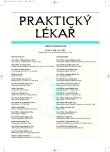An update on the Global strategy for asthma management and prevention – as viewed from the current situation in the Czech Republic
Aktualizace světového doporučení pro diagnostiku, léčbu a prevenci astmatu – z pohledu současné situace v České republice
Ve článku je diskutovaný recentně vydaný dokument týkající se diagnostiky, léčby a prevence asthma bronchiale, který vydala v listopadu roku 2006 Globální iniciativa pro astma (GINA) pod patronací WHO, z pohledu současné situace na poli astmatu v České republice. Ve srovnání s předchozími nový dokument obsahuje zásadní změny v přístupu k léčbě astmatu. Hlavním cílem léčby je kontrola astmatu a její dlouhodobé udržení. Úroveň kontroly astmatu je třístupňová a s ní související farmakoterapie je nyní pětistupňová. Lékem prvé volby perzistujícího astmatu pro všechny věkové kategorie jsou inhalační kortikosteroidy (IKS), pokud není monoterapií IKS dosaženo astmatu pod kontrolou, jsou aditivními léky prvé volby inhalační beta2-mimetika s dlouhodobým účinkem (LABA), která je však nyní nutno podávat zásadně v kombinaci s IKS, což reflektuje i vzrůstající úloha léčbou fixními kombinacemi. Jako velmi efektivní se ukazuje nový koncept léčby astmatu kombinací budesonid/formoterol, která používá jeden inhalační systém k dlouhodobé udržovací léčbě a zároveň k úlevové léčbě v případě potřeby. Pacienti s astmatem, u kterých nelze dosáhnout kontroly astmatu léčbou odpovídající stupni 4, mají obtížně léčitelné astma bazálně charakterizované špatnou odpovědí na léčbu kortikosteroidy.
Klíčová slova:
asthma bronchiale, farmakoterapie, kontrola astmatu, obtížně léčitelné astma.
Authors:
V. Kašák
Authors‘ workplace:
LERYMED spol. s r. o.
; Oddělení respiračních nemocí, Praha
4
Published in:
Prakt. Lék. 2007; 87(4): 210-215
Category:
Reviews
Overview
The article reviews the Global strategy for asthma diagnosis, treatment and prevention as outlined in the GINA (Global Initiative for Asthma – under patronage of the WHO) publication of November 2006, as seen from the current asthma situation in the Czech Republic. The new publication contains fundamental changes in the approach to asthma treatment not noted in previous editions. The main aim of asthma treatment is achieve, and then maintain, clinical control. There are three levels of asthma control (controlled, partly controlled and uncontrolled asthma) and now five steps of asthma pharmacotherapy. Low dose inhaled glucocorticosteroids are the preferred initial controller treatment for patients of all ages with persistent asthma.
The first choice additional therapy is long-acting β2-agonists (LABA). But long-acting β2-agonists must only be used in combination with an appropriate dose of inhaled glucocorticosteroids. The use of the combination of a rapid-acting long-acting β2-agonist (formoterol) and an inhaled glucocorticosteroid (budesonide) in a single inhaler, both as a controller and reliever, is very effective and is a new concept in asthma therapy. Patients with asthma that do not reach an acceptable level of control at step 4 are considered to have difficult-to-treat asthma, characterised by a poor responsiveness to glucocorticosteroid treatment.
Key words:
asthma, pharmacotherapy, control of asthma, difficult-to-treat asthma.
Labels
General practitioner for children and adolescents General practitioner for adultsArticle was published in
General Practitioner

2007 Issue 4
- Memantine Eases Daily Life for Patients and Caregivers
- Metamizole vs. Tramadol in Postoperative Analgesia
- Metamizole at a Glance and in Practice – Effective Non-Opioid Analgesic for All Ages
- Memantine in Dementia Therapy – Current Findings and Possible Future Applications
- What Effect Can Be Expected from Limosilactobacillus reuteri in Mucositis and Peri-Implantitis?
Most read in this issue
- Todays trends of diagnostics and treatment of scaphoid bone fractures
- Extensive trombosis of thoracic aorta – an unusual source of acute peripheral arterial embolism.
- Epileptic fit as a syncope equivalent in severe aortic stenosis.
- Smoking and skin
